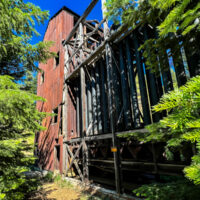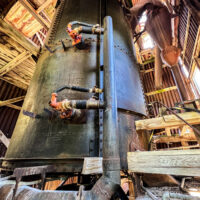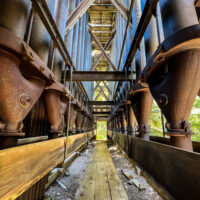On a past visit to the area I had tried to find this mill building, I missed it by mere yards, a few trees away. This time I was going to succeed.
The Mother Lode Mine is a mercury mine in the Ochoco Mountians of central Oregon. Here cinnabar ore was crushed and roasted to release quicksilver that would have been used in the region’s gold mines.
First claimed as a gold mine in 1899, mercury was discovered in 1900, mining continued off and on under various mining companies until 1968. Total production was likely around 352 flasks, or about 2,900 pounds of mercury.
The attraction here was the old mill itself, a lovely example of mining technology. In addition to being still standing, odd enough, it is quite photogenic. The mill is located high on the northern slopes of Lookout Mountain among pine forest and meadows of wildflowers.
My first attempt at the mine was in 2017, again on the way to Oregon Star Party. I knew pretty much where the mill building was, but in a thick forest it is so easy to miss something, even something four stories tall. Attempting to check the map or satellite images was frustrated by the lack of cell service. Thus while I enjoyed a hike and located a collection of mine workings and ruins, I missed the one building I set out to find.
Try number two… Having had the benefit of another look at the satellite images I found I had passed just uphill of the mill, frustratingly close, but still missed it. This time I downloaded the maps and satellite images, only to find that cell service had improved and reception was fine. I walked straight to the mill.
There are two official forest service trails leaving the trailhead at the end of the road, one passes well uphill of the mill, one passes well downhill of the mill. A wildcat trail along an overgrown roadbed splits the difference and goes directly to the mill building. If I had taken the lower trail I would have seen the mill above me.
The building is simply cool, much of the equipment still in place, I spend a while trying to figure out the eqiupment. Being a cinnbar mill this equipment is notably different that the usual crushers and concentrators. This mill would have directly produced pure mercury from the ore, not a concentrate to be hauled off for smelting elsewhere.
The furnace is obvious enough, the burners, blower, and a separator identifiable. Still I am not quite certian how it is supposed to work, some of the arrangements are quite curious. Much of the structure is a huge set of metal piping, it is this impressive structure that I just cannot figure out.
It is not until I do a little more research that the entire facility makes sense. Digging about online I find an interesting article on processing stibnite and cinnabar mercury ores. The article includes detailed information on chemical reactions, the temperatures required, and specific information on the equipment used with drawings. Drawings that look much like what I found in the mill. With this information I review the photos I took and it all comes together.
First off the furnace is a fluidized bed setup where finely crushed ore is fed into the lower part of the furnace and fluidized by a large blower while heated by a set of burners to around 500°C. All of this equipment I can now identify in the photos. The mercury is vaporized and exits though a large pipe at the top of the furnace where a cyclone separator removes any dust that was carried with the hot gas.
The large pipe structure? It is the condenser! Here the gas cools and allows the mercury to condense, to eventually be collected at the bottom of each tube set where little ports are available in the iron castings. It is the massive size of the condenser that surprises me. I would have expected a water cooled condenser, which would have been far smaller, but this is an air cooled condenser the size of a house.
For a little side trip on the way to a star party the Mother Lode Mine was well worth the time. A fun little adventure and a chance to resolve a previous mission failure.














Andrew,
Thanks for the info. Looks like an interesting site when I go to sunny central Oregon from Seattle.
Paul